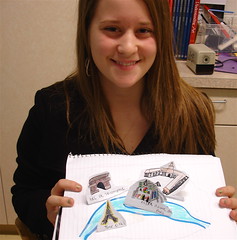Monuments of Paris project
Sketching the landmarks of Paris is one way of establishing this city in your mind and memory.
a) Sketch, color and label the Seine R, including the Ile de Paris ( an island in the river).
b) Sketch, color and cut out (with tabs) the 4 monuments (all to be completed in your notebook).
c) Glue the monuments' tabs to the page in the appropriate location.
d) Print 4 brief items of info next to each of the monuments.
e) Add a small, colorful map of France. Identify neighbors Belgium, Germany, Switzerland, Italy and Spain.
e) Top the page with a snappy title and explanatory subtitle.
18 pts.
Deadline on Thurs/Fri.
I suggest these as the most significant monuments -
1. Le Tour Eiffel.
The Eiffel Tower (French: Tour Eiffel, [tuʀ ɛfɛl]) is a 19th century iron lattice tower located on the Champ de Mars in Paris. The Eiffel Tower, which is the tallest building in Paris,[10] is the single most visited paid monument in the world; millions of people ascend it every year. Named after its designer, engineer Gustave Eiffel, the tower was built as the entrance arch for the 1889 World's Fair.
The tower stands at 324 m (1,063 ft) tall, about the same height as an 81-story building. It was the tallest structure in the world from its completion until 1930, when it was eclipsed by the Chrysler Building in New York City.
2. The Palais du Louvre
The Musée du Louvre is one of the world's largest museums, the most visited museum in the world, and a historic monument. It is a central landmark of Paris, France and is located on the Right Bank of the Seine in the 1st arrondissement (district). Nearly 35,000 objects from prehistory to the 19th century are on exhibit.
The museum is housed in the Louvre Palace (Palais du Louvre) which began as a fortress built in the late 12th century under Philip II. The building was extended many times to form the present Louvre Palace. In 1672, Louis XIV moved to the Palace of Versailles with his household, leaving the Louvre primarily as a place to display the royal collection.[3] During the French Revolution, the National Assembly decreed that the Louvre should be used as a museum, to display the nation's masterpieces.
3. Notre Dame de Paris
Notre Dame de Paris (in English: Our Lady of Paris), also known as Notre Dame Cathedral, is a Gothic, Roman Catholic cathedral on the Île de la Cité. It was built during the 1100's and 1200's.
Notre Dame de Paris was among the first buildings in the world to use the flying buttress (arched exterior supports). The building was not originally designed to include the flying buttresses around the choir and nave. After the construction began and the thinner walls (popularized in the Gothic style) grew ever higher, stress fractures began to occur as the walls pushed outward. In response, the cathedral's architects built supports around the outside walls, and later additions continued the pattern.
4. Arc de Triomphe
The Arc de Triomphe (built 1810 - 1840) is a monument in Paris that stands in the centre of the Place Charles de Gaulle, also known as the "Place de l'Étoile".[1] It is at the western end of the Champs-Élysées. The triumphal arch honors those who fought for France, particularly during the Napoleonic Wars.
It is the second largest triumphal arch in existence.[2] Its design was inspired by the Roman Arch of Titus.
skip to main |
skip to sidebar
For students and parents who love education and exploration of the social sciences . . .
Search This Blog
Followers
Blog Archive
-
▼
2010
(346)
-
▼
November
(24)
- Reading and reporting about France in World Geo, p...
- Indie work: Make a Quiche Lorraine to be sampled b...
- One of man's most ancient sources of protein: esca...
- The French and advanced technology
- Western Europe / France / Monuments of Paris project
- Nature trail hike on the perimeter of the Magnet c...
- Weather permitting, classes will take an instructi...
- Learning the map of the UK via symbols
- The Yankee states and the Big Apple test / Trudeau
- Small group tutoring - Writer's Workshop on Thurs ...
- Indie essays on England
- Norton Commando 850 / British motorcycles
- England was part of the Roman Empire; they called ...
- Iron & steam: the Industrial Revolution began in E...
- The modern history of the United Kingdom, aka Grea...
- NE states & Manhattan test next class
- The Thames, the Tower Bridge and the Tower of Lond...
- Britain and neighbors, the Western European nations
- West Side Story / Puerto Rico: US Possession conne...
- NYC: the Erie Canal and the Broadway show, "Annie"
- What to know about NYC
- Historic Manhattan: the Chrysler Building, New York
- Choices available in Indie essays
- Map quizzes: the twelve Midwest states followed by...
-
▼
November
(24)

